Engage NY Eureka Math 8th Grade Module 2 Lesson 12 Answer Key
Eureka Math Grade 8 Module 2 Lesson 12 Exploratory Challenge Answer Key
Exploratory Challenge 1.
In the figure below, L1 is not parallel to L2, and m is a transversal. Use a protractor to measure angles 1–8. Which, if any, are equal in measure? Explain why. (Use your transparency if needed.)
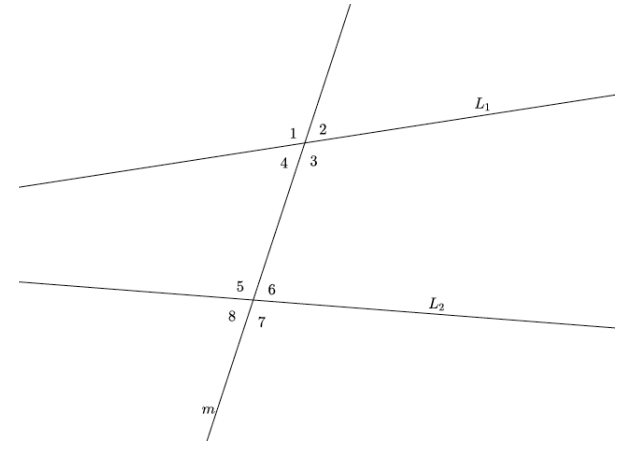
Answer:
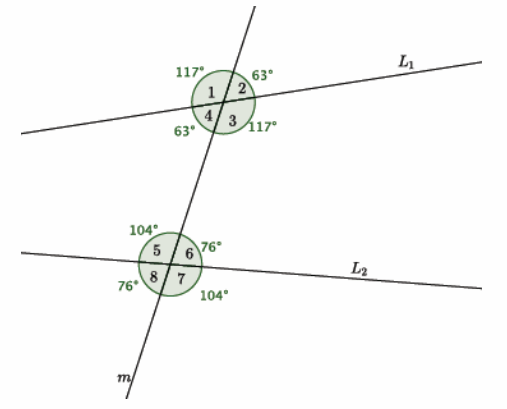
The following angle measures are equal: ∠1=∠3, ∠2=∠4, ∠5=∠7, and ∠6=∠8. The pairs of angles listed are equal because they are vertical angles. Vertical angles are always equal because a rotation of 180° around the vertex of the angle will map it to its opposite angle.
Exploratory Challenge 2.
In the figure below, L1 || L2, and m is a transversal. Use a protractor to measure angles 1–8. List the angles that are equal in measure.

Answer:
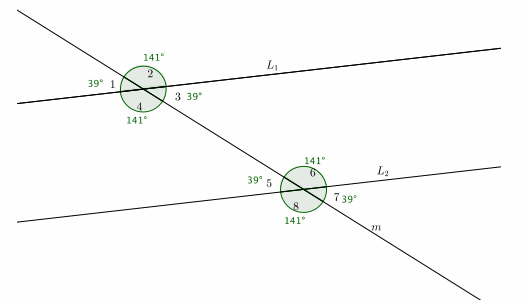
∠1=∠3=∠5=∠7 and ∠2=∠4=∠6=∠8
a. What did you notice about the measures of ∠1 and ∠5? Why do you think this is so? (Use your transparency if needed.)
Answer:
∠1 and ∠5 are equal in measure. We can translate ∠1 along a vector on line m so that the vertex of ∠1 maps onto the vertex of ∠5. Translations are angle-preserving, so the two angles will coincide.
b. What did you notice about the measures of ∠3 and ∠7? Why do you think this is so? (Use your transparency if needed.) Are there any other pairs of angles with this same relationship? If so, list them.
Answer:
∠3 and ∠7 are equal in measure. We can translate ∠3 along a vector on line m so that the vertex of ∠3 maps onto the vertex of ∠7. Translations are angle-preserving, so the two angles will coincide. Other pairs of angles with this same relationship are ∠4 and ∠8 and ∠2 and ∠6.
c. What did you notice about the measures of ∠4 and ∠6? Why do you think this is so? (Use your transparency if needed.) Is there another pair of angles with this same relationship?
Answer:
The measures of ∠4 and ∠6 are equal. A rotation of 180° around a center would map ∠4 to ∠6. Rotations are angle-preserving, so we know that ∠4 and ∠6 are equal. ∠3 and ∠5 have the same relationship.
Eureka Math Grade 8 Module 2 Lesson 12 Problem Set Answer Key
Students practice identifying corresponding, alternate interior, and alternate exterior angles from a diagram.
Use the diagram below to do Problems 1–10.
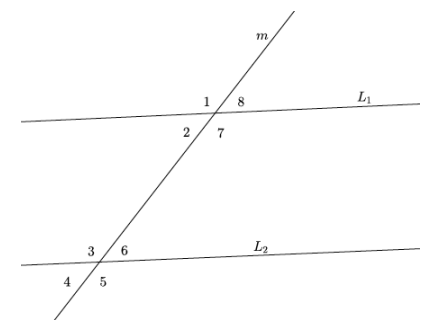
Question 1.
Identify all pairs of corresponding angles. Are the pairs of corresponding angles equal in measure? How do you know?
Answer:
∠1 and ∠5, ∠4 and ∠8, ∠2 and ∠6, ∠3 and ∠7
There is no information provided about the lines in the diagram being parallel. For that reason, we do not know if the pairs of corresponding angles are equal in measure. If we knew the lines were parallel, we could use translation to map one angle onto another.
Question 2.
Identify all pairs of alternate interior angles. Are the pairs of alternate interior angles equal in measure? How do you know?
Answer:
∠4 and ∠5, ∠3 and ∠6
There is no information provided about the lines in the diagram being parallel. For that reason, we do not know if the pairs of alternate interior angles are equal in measure. If the lines were parallel, we could use rotation to show that the pairs of angles would map onto one another, proving they are equal in measure.
Question 3.
Use an informal argument to describe why ∠1 and ∠8 are equal in measure if L1 || L2.
Answer:
The reason that angle 1 and angle 8 are equal in measure when the lines are parallel is because you can rotate around the midpoint of the segment between the parallel lines. A rotation would then map angle 1 onto angle 8, showing that they are congruent and equal in measure.
Question 4.
Assuming L1∥L2, if the measure of ∠4 is 73°, what is the measure of ∠8? How do you know?
Answer:
The measure of ∠8 is 73°. This must be true because they are corresponding angles of parallel lines.
Question 5.
Assuming L1 || L2, if the measure of ∠3 is 107° degrees, what is the measure of ∠6? How do you know?
Answer:
The measure of ∠6 is 107°. This must be true because they are alternate interior angles of parallel lines.
Question 6.
Assuming L1 || L2, if the measure of ∠2 is 107°, what is the measure of ∠7? How do you know?
Answer:
The measure of ∠7 is 107°. This must be true because they are alternate exterior angles of parallel lines.
Question 7.
Would your answers to Problems 4–6 be the same if you had not been informed that L1 || L2? Why or why not?
Answer:
No. The fact that the lines are parallel is the reason we can state that specific pairs of angles are equal in measure. We can use basic rigid motions to prove that angles associated with parallel lines have the property of being equal in measure when they are corresponding, alternate interior, or alternate exterior angles. If the lines are not parallel, then we could still classify the angles, but we would not know anything about their measures.
Question 8.
Use an informal argument to describe why ∠1 and ∠5 are equal in measure if L1 || L2.
Answer:
The reason that angle 1 and angle 5 are equal in measure when the lines are parallel is because you can translate along a vector equal in length of the segment between the parallel lines; then, angle 1 would map onto angle 5.
Question 9.
Use an informal argument to describe why ∠4 and ∠5 are equal in measure if L1 || L2.
Answer:
The reason that angle 4 and angle 5 are equal in measure when the lines are parallel is because when you rotate angle 4 around the midpoint of the segment between the parallel lines, angle 4 will map onto angle 5.
Question 10.
Assume that L1 is not parallel to L2. Explain why ∠3≠∠7.
Answer:
If the lines are not parallel, then all we know about angle 3 and angle 7 is that they are corresponding angles. If the lines are parallel, we could use translation to map one angle onto the other to show that they are equal in measure. However, we are to assume that the lines are not parallel, which means that their corresponding angles will not be equal in measure.
Eureka Math Grade 8 Module 2 Lesson 12 Exit Ticket Answer Key
Use the diagram to answer Questions 1 and 2. In the diagram, lines L1 and L2 are intersected by transversal m, forming angles 1–8, as shown.
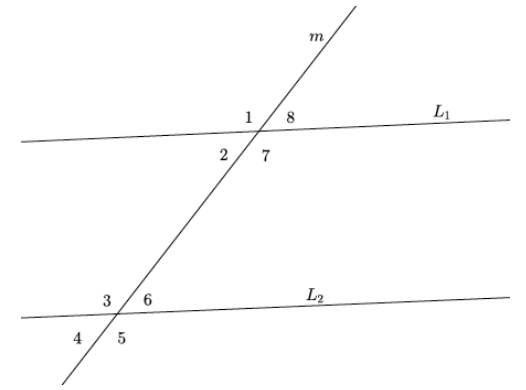
Question 1.
If L1 || L2, what do you know about ∠2 and ∠6? Use informal arguments to support your claim.
Answer:
They are alternate interior angles because they are on opposite sides of the transversal and inside of lines L1
and L2. Also, the angles are equal in measure because the lines L1 and L2 are parallel. If we rotated angle 2 180° around the midpoint of the segment between the parallel lines, then it would map onto angle 6.
Question 2.
If L1 || L2, what do you know about ∠1 and ∠3? Use informal arguments to support your claim.
Answer:
They are corresponding angles because they are on the same side of the transversal and above each of lines L1
and L2. Also, the angles are equal in measure because the lines L1 and L2 are parallel. If we translated angle 1 along a vector (the same length as the segment between the parallel lines), then it would map onto angle 3.